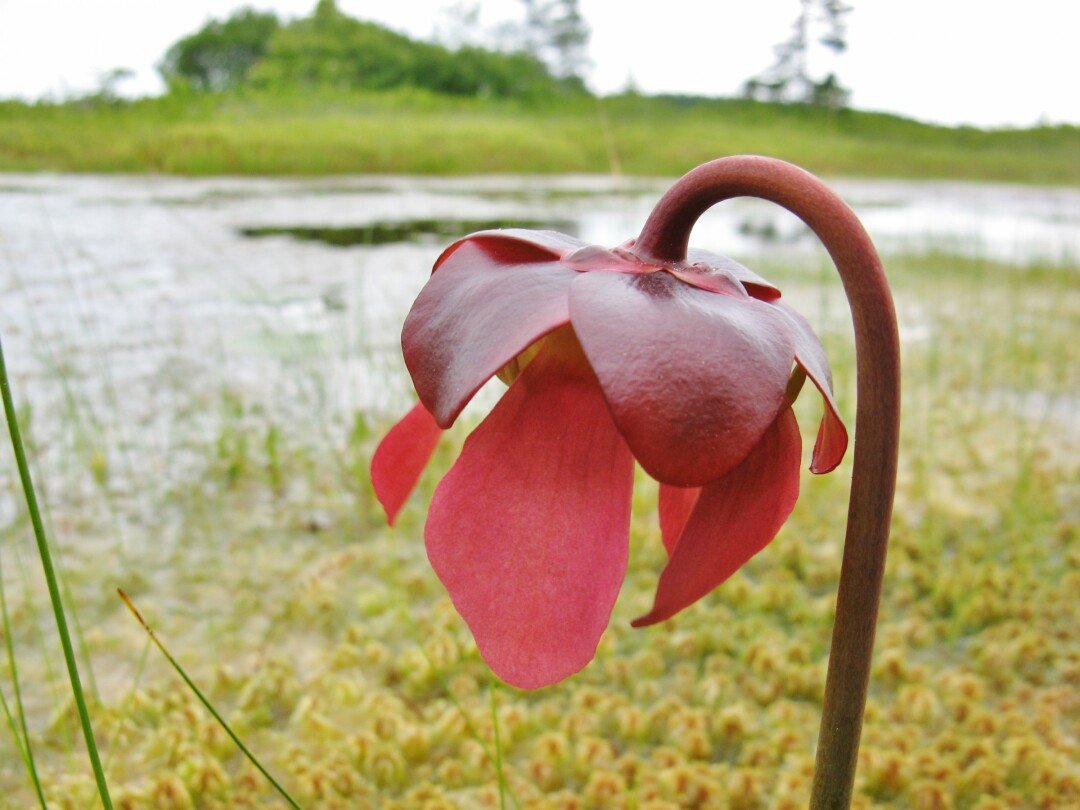News & Articles
Browse all content by date.
 Pitcher plant flowers have beautiful and ephemeral petals, but their main structure can be seen in the bog throughout most of the year. Photos by Emily Stone.
Pitcher plant flowers have beautiful and ephemeral petals, but their main structure can be seen in the bog throughout most of the year. Photos by Emily Stone.
Well, April is an interesting month in the Northwoods, and spring seems to be coming in fits and starts. Many trails are muddy right now, and hikers should be careful about the impact their boots make in the wet soil. For now, I’ll content myself with walking on roads and writing about the Forest Lodge Nature Trail.
This week, the sections I’m sharing from the trail’s new interpretive booklet include one of my favorite topics. I love bogs, I love bog plants. The pages in this booklet are short, and I left out many of my favorite facts. If you’d like to learn more, you can access my blog/archive and search for “bog.” As always, please contact me with corrections or ideas – the booklet is still in draft form!
The Forest Lodge Nature Trail has a lovely bog boardwalk to give you easier access to this fragile ecosystem. Some trails in Wisconsin have been closed recently, so it’s important to check before you go, stay close to home, use proper hygiene (including dealing with waste properly) and be extra cautious so you don’t stress our emergency response system. Whether you visit the trail in person or in your imagination, happy hiking!
With cold, acidic, low-oxygen water, decomposition proceeds slowly in bogs and fens. Without decomposition to return nutrients to the system, they are challenging places to live, and the plants that can survive have unique adaptations.
Sphagnum moss plays a big role in bog and fen formation. Sphagnum’s primitive leaves are like tiny sponges, and can absorb up to 26 times their own weight in water. Because of this trait, it has been used for diapers and bandages. To deal with the lack of available minerals, sphagnum shoots hydrogen ions into its environment – dislodging scarce nutrients for its own use. This acidifies the bog or fen, which further limits which plants can grow there.
 Leatherleaf forms a living scaffolding around the edges of bogs, and sphagnum moss uses it to extend the bog mat.
Leatherleaf forms a living scaffolding around the edges of bogs, and sphagnum moss uses it to extend the bog mat.
Leatherleaf is a hardy shrub with leathery, oval leaves that hang on through the winter. It’s rigid stem and wiry branches are the scaffolding that support sphagnum moss as the vegetation mat grows inward from the edges of the basin. In the middle of the bog, leatherleaf forms the base of mounds called hummocks. Leatherleaf obtains nutrients through a partnership with fungi on its roots.
Pitcher plant is a carnivorous plant with leaves that hold water. Their dark red flowers bloom in June, and their seed heads poke above the bog like periscopes for most of the year. In order to get enough nitrogen and phosphorus, pitcher plants lure insects to the trap of their water-filled leaves. Then fly larvae, mosquito larvae, and midge larvae who are living in the pitcher help the plant digest and absorb the nutrients it needs. These mosquitoes eat so well that they don’t need to drink blood!
Logs into soil
How many rotting logs can you see from where you stand?
Those trees once grew using carbon from the air and nutrients from the soil. Now they are decomposing and the forest is recycling their resources.
Much like the snag and the nurse stump, these logs are filled with life. Moss and lichens keep them moist. Fungi soften the wood. Beetles, ants, and other invertebrates chew tunnels. Spiders, crickets, firefly larvae, salamanders, and mice find cozy homes.
As the logs decay, they replenish the soil’s nutrients and help the soil retain moisture so that new trees can grow. They are an important part of the cycle of life.
 The uniquely shaped leaves of pitcher plants act as insect traps. These carnivorous plants rely on insects to acquire enough nutrients to survive in the challenging habitat of bogs and fens.
The uniquely shaped leaves of pitcher plants act as insect traps. These carnivorous plants rely on insects to acquire enough nutrients to survive in the challenging habitat of bogs and fens.
Local logging history
The lumber industry in Wisconsin faced many obstacles as it began in the 1830s. Bogs, wetlands and dense forests prevented easy travel. The railroad reached Cable in 1880, and the lumberjacks came with it.
Teams of draft horses hauled huge loads of pine and hemlock along this logging road. Once the lumbermen reached camp on nearby Lake Namakagon, the logs were rolled into the lake and floated to sawmills on the Namakagon River. There they were cut into lumber and transported by train. The railroad reached Cable in 1880.
Look for large, rotting stumps left over from the logging era. As new life takes them over, they represent both the past and the future of this forest.
Thanks to Wisconsin Master Naturalist Volunteers Thom Gerst and Kay Meyer for their help in drafting this booklet!
Emily’s second book, Natural Connections: Dreaming of an Elfin Skimmer, is now available to purchase at cablemuseum.org/books. Or order it from our friends at redberybooks.com to receive free shipping!
For more than 50 years, the Cable Natural History Museum has served to connect you to the Northwoods. The Museum is currently closed due to COVID-19, but we’re still building our new exhibit and bringing you educational content. Connect with us on Facebook and Instagram to see what we are up to.
| Tweet |


